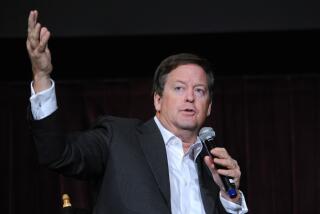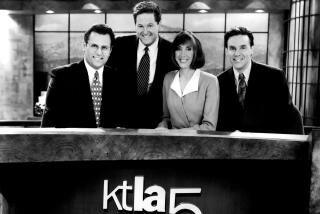KCAL’s Jackson Is No Mickey Mouse Reporter
- Share via
“I was on my own. I could do what I wanted. I had a ton of air time.”
The offer was one he couldn’t refuse. So on Aug. 5--three days after Iraq caused a crisis in the Persian Gulf region by invading Kuwait--the local anchorman with the solidified blond coif and stereotypical TV looks flew to the Middle East.
Uh oh. Would he be able to buy his brand of hair spray in Jordan, yuk, yuk, yuk?
David Jackson affirmed over the next 54 days, however, that he is far from being just another pretty face. His work in the gulf region--reporting live three to four times nightly on KCAL Channel 9--was something to behold.
One-man bands like Jackson are poor bets to break stories in the gulf region, especially if they don’t speak Arabic (he doesn’t) and haven’t been there before (he hadn’t). For sheer persistence and productivity alone, however, Jackson deserves high praise. And that he was able to maintain his grueling on-air pace without babbling incoherently--his reports, often packaged with material from CNN and other KCAL sources, were almost always intelligent and well-measured--is an achievement of its own. All things considered, the man was terrific.
Showing a sense of humor, KNBC Channel 4 sent anchor Colleen Williams to Saudi Arabia for a week. KTTV Channel 11 briefly sent consumer reporter Tom Vacar to the region, where he seemed to vanish like a speck in the sand. KABC Channel 7 assigned free-lance Middle East specialist Alex Paen to the gulf region for a short period, and Paen did an especially good job reporting from Baghdad.
But it was Jackson’s often-personalized and conversational live reports that, over the long haul, most closely connected the crisis to local viewers. As a bonus, he gave KCAL one of its rare class acts and an edge over the competition in covering this story.
It’s an example of how media--in this case a Disney-owned station hoping to throw a spotlight on its relatively new three-hour prime-time news block--can at once cover and benefit from a story.
“They (Disney executives) wanted to have a real strong presence on a large scale and wanted to find a story that would fall into place for them,” said Jackson, who is now back co-anchoring KCAL’s 9 p.m. newscast after returning home Sunday. “It could have been an emergency or a plane crash somewhere. But when this broke, it didn’t take those guys more than 24 hours to see that it would be the kind of story we could run with.”
As one of KCAL’s very few capable on-screen journalists, Jackson was the ideal gulf marathoner, combining visibility and promotional value as an anchor with experience as a reporter both domestically and abroad. The latter includes assignments in Argentina during the Falklands war in 1982 and in the Philippines during the Marcos vs. Aquino election in 1986, both while Jackson was at KPIX-TV in San Francisco.
He carried a heavy burden in the Middle East. “You’re feeling the pressure because you’ve spent a lot of money and you want to show something for it,” Jackson said. What he showed for it were extensive live reports and chats with the other anchors on the 8, 9 and 10 p.m. newscasts, and also at 11 p.m. during the three weeks that KCAL ran a gulf special at that hour.
Jackson: “The only thing that went through my mind was, ‘How was I going to do the same story four different ways so that the people would tolerate it?’ I was trying to vary the material enough so that it was not repetitious or, if not a whole lot happened on that given day, I wanted to give it the kind of energy that this story was a significant event and you should know it.”
He also faced the added pressure of having to try daily to gain access to the epicenters of the gulf crisis. Although based mostly in Amman, Jordan, he reported from half a dozen gulf nations while in the region.
But not from the Big Two: not from Saudi Arabia, where U.S. forces were continuing their buildup, and not from Iraq.
In the case of KNBC’s Williams, getting to Saudi Arabia via an Air Force plane was made easier by the fact that she not only came from a military family but also represented a powerful NBC station. And KABC’s Paen not only was backed by a big ABC station but also had his own contacts that he says helped him gain a visa for Iraq.
Jackson, however, had only one name he could throw out in hopes of convincing the Iraqis and Saudis to grant him entry, only one name he hoped would dazzle them into giving him visas.
Walt Disney.
The region’s general “bureaucratic tangle” and his lack of a network affiliation did him in, Jackson believes. “I’ve never worked for an independent station like KCAL before. When you tell them (Middle Easterners) it’s the Walt Disney Co., they don’t quite get it. Every other day I would go see the man in the Iraqi embassy in Amman who handles every application to get into Iraq.”
And? “He’d ask me about Mickey Mouse.”
As it turned out, Jackson’s Iraqi visa ultimately did come through, but only when he was preparing to return home. “By that time it wasn’t a critical need and I already had one foot out the door.”
Meanwhile, there were always Bahrain or Egypt or Turkey or the United Arab Emirates, and Jackson estimates that he logged up to 15,000 air miles while in the region, hoping to make up for being shut out of Iraq and Saudi Arabia .
On one trip to Bahrain, Jackson said, he and his crew deplaned at the airport only to be immediately booted out because of their TV camera.
“You get this constantly,” Jackson said. “I mean, the paperwork and the guy at the airport who doesn’t understand why you’re there and why you’ve got 10 bags and why you have a battery charger and why you need the camera. You explain yourself a zillion times, ‘This is television.’ But to these societies, the presence of a television camera is incredibly bizarre, and you’re constantly fighting that. When you got out on the street with a camera, the guy on the street might turn you in.”
I t didn’t help also that Jackson had no regular camera crew (sending one would have dramatically raised KCAL’s costs). He worked with 18 separate international crews, having to bargain with them like a rug merchant.
“I would shoot tape of a refugee camp with somebody, do stand-ups, sound bites and some other stuff, then I’d go to Dubai television and say, ‘I’ve got some nice stuff of refugee camps. If you want it, you can use it if you give me a camera tomorrow for an hour and a half.’ ” On occasion, he would trade a bit of KCAL’s satellite time for use of a camera crew.
Jackson said that a standard 10-minute window of satellite time costs about $5,000, plus $2,000 for each additional minute. “You’re such a slave to technology over there,” he said. “You have to book these satellite windows at hard-and-fast times. And when you get into free-form questions and answers on the air (at which Jackson particularly excels), you eat up that time fast.”
A typical 16-hour day at the office for Jackson in Amman went like this: At 3:30 a.m., he got a wake-up call from KCAL (where it was 5:30 p.m.), followed by an update on what relevant stories had been on the wires and on the air while he slept. Then Jackson and a KCAL writer in Los Angeles would go over “that day’s stuff.” Then he would cut audio tracks over the phone. He would leave his hotel at 5 a.m. and head for the satellite uplink station. By 6 a.m., he was in position for his live feed to KCAL’s 8 p.m. newscast, and he would repeat the procedure for subsequent newscasts, before finishing at 9 a.m. or 10 a.m. Then perhaps he would hop a ride to a story with a TV crew, and so on and so on, day after day after day.
“It’s a grind, and physically very tough because you don’t have weekends off and don’t have recuperative time,” Jackson said. “But you’re excited.”
Now it’s back to anchoring. “You never have the adrenaline and the out-and-out rush of reporting a breaking story, but it’s nice in its own way,” he said. “It’s sort of comfortable.”
More to Read
The complete guide to home viewing
Get Screen Gab for everything about the TV shows and streaming movies everyone’s talking about.
You may occasionally receive promotional content from the Los Angeles Times.






